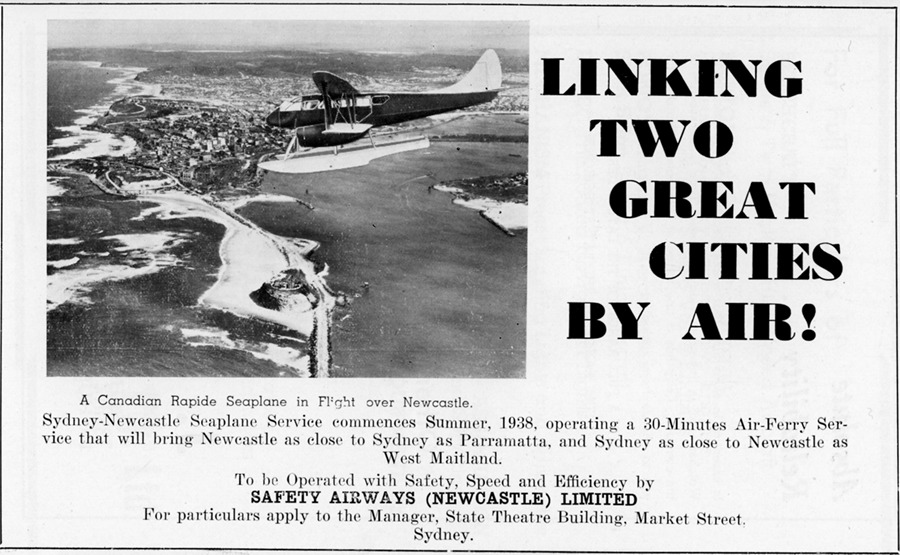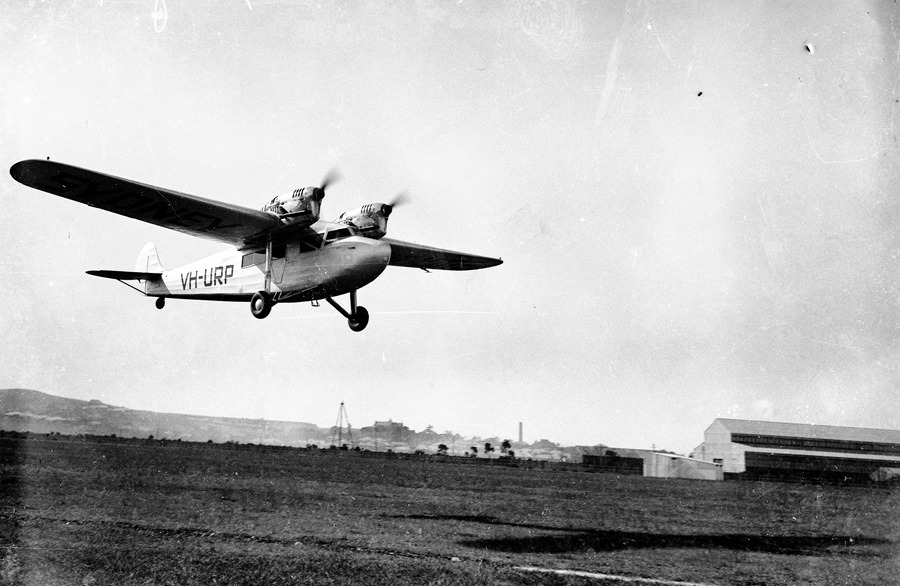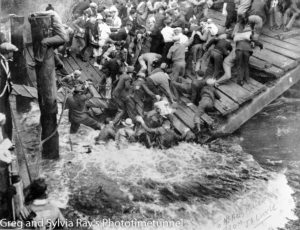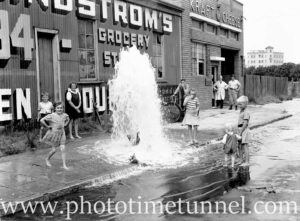Early efforts to bring commercial aviation to Newcastle, NSW, were many, but largely unsuccessful. A push by Charles Kingsford Smith and some of his supporters to create Australia’s biggest aerodrome at Walsh Island were almost successful, but fell victim to politics and – most likely – the onset of the Great Depression.
The first reference I’ve found to a commercial air service being offered to Newcastle residents is this article in The Sydney Morning Herald on January 29, 1920, in which “Mr H. E. Broadsmith, engineer-in-chief to the Australian Engineering and Aircraft Company, who accompanied Mr Nigel Love in the Avro aeroplane to Newcastle on Monday” declared that the route between Newcastle and Sydney was ideal for seaplanes. The Avro also visited Maitland and, on its return from Newcastle to Sydney, it carried the Mayor of Newcastle, Alderman Gibson, who said the scenery was wonderful despite the cold at 6000 feet and the strong headwind. He was so impressed by his flight he declared that he was going to push for a suitable landing ground to be set aside at Newcastle. Mr Broadsmith said that: “So confident are we of the success of this air service that we will have a seaplane ready for the route at the end of next week and hope to have regular services established at an early date”. It does not appear that this regular service actually came about.
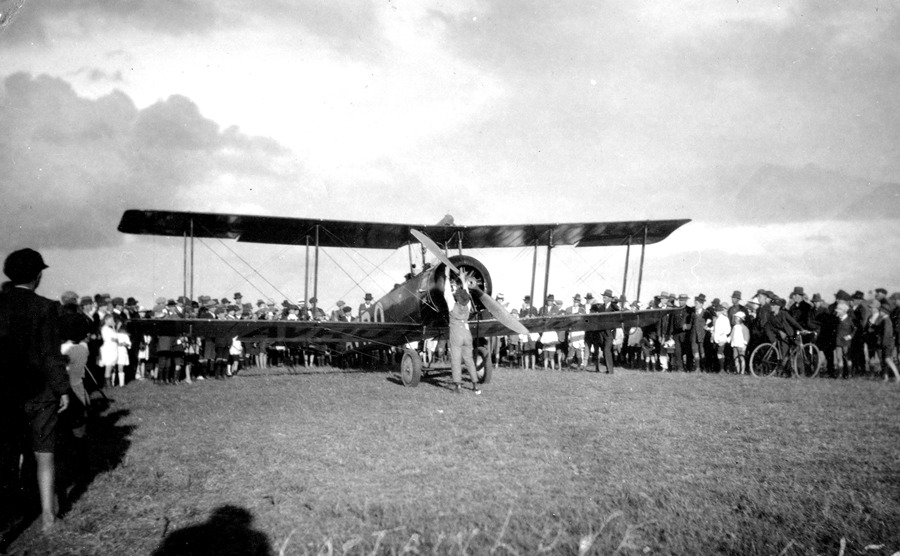
The need for a proper landing ground was underscored the following year when renowned aviator Bert Hinkler was forced down in a squall after seven hours flying from Bundaberg and had to land on the beach at Anna Bay. “He walked ten miles through the scrub, looking for help, stayed the night at a farm house and towed his machine to Newcastle next day. He is taking the machine to Sydney by boat tonight”.
Another aviation plan was outlined in this article in The Newcastle Sun of September 24, 1921. The enterprise was known as Commercial Air Transport Limited and it proposed a freight service as well as offering an air taxi in well-populated districts. The company was selling shares at the time and it isn’t clear whether it “got off the ground”
Some years later came this Newcastle Sun article, in November 1927, describing how Captain Hammond of the Golden Aircraft Company, Mascot, would be offering flights to Newcastle residents. His Golden Moth plane was described as “the only air taxi in Australia”, operating flights out of Mascot to anywhere in Australia for one shilling a mile.
In March 1929 Sir Charles Kingsford Smith announced that his Australian National Airways would operate flights between Melbourne, Sydney, Newcastle and Brisbane, using a fleet of five three-engined Avro-Fokkers capable of carrying eight passengers. In September of the same year, a director of ANA, Mark Reid, stated in this article that Newcastle and Lismore would be stops en-route between Sydney and Brisbane. At Newcastle ANA’s planes would land at an airstrip at Walsh Island, near the government dockyard. According to this article, work on the Walsh Island aerodrome was “steadily progressing and even at the present time safe landing is assured for passenger planes”. Suitable hangars were to be built, and a big advantage of Walsh Island was its suitability for seaplanes as well as land-based aircraft. The fare between Newcastle and Sydney was to be £2, Newcastle and Lismore £4, and Newcastle and Brisbane £6. Passengers would travel from Walsh Island to Newcastle city by fast motor boat.

Newcastle Aero Club had been founded at a meeting in the then Newcastle Council Chambers in Watt Street on October 11, 1928 and the club immediately began pursuing its goal of establishing a flying school. According to a programme for the club’s inaugural Air Pageant in December 1929: “After inspecting almost every available field between Redhead on the south and Tarro on the north, the committee ultimately decided to co-operate with the management of Walsh Island. The construction of the aerodrome was commenced about twelve months ago. Herculean efforts have been made by the management and staff of Walsh Island to have the surface completed for this pageant, but, unfortunately, the area surfaced was not quite sufficient for this purpose. It is the opinion of experts that with the present rate of progress the aerodrome at Walsh Island will be suitable for training purposes within three months”. A promotional brochure issued by the Walsh Island dockyard stated that the aerodrome comprised “three runways each 160 feet wide and approximately 2500 feet long, situated in the direction of the prevailing winds, enabling planes to land in any direction on the site. Special provision is being made for the establishment of a sea plane base to be used in conjunction with this aerodrome.” It was reported at the time that the Walsh Island aerodrome would be the biggest in Australia. It is clear that the dockyard management expected major future benefits in aircraft manufacture and repair, as well as probable rental income from the aero club and from commercial air service operators. Kingsford Smith evidently agreed, and on June 13, 1929, Kingsford Smith’s partner Charles Ulm was the first airman to land at the Walsh Island aerodrome.
Walsh Island controversy
The Commonwealth Defence Department promised the aero club that as soon as Walsh Island was licensed as an aerodrome, two DH Moth aeroplanes, together with a spare engine, would be made available for club training. But the Walsh Island scheme fell apart. According to the aero club’s tenth anniversary souvenir booklet, Wings Over the North, “Civil Aviation Department officials finally recommended that a site be sought elsewhere.” It appears that the dockyard management was rapped over the knuckles by the NSW Auditor-General for spending more than £10,000 on the aerodrome without government approval. This criticism helped trigger an inquiry into the dockyard’s management and led to the general manager, A. C. Waters, being dismissed and replaced by a committee of management. It seems the criticism was somewhat unreasonable, since the government was clearly in the loop over the aerodrome plans, as this article shows. The Minister for Public Works, Mr Buttenshaw, actually officially opened the aerodrome in December 1929, in conjunction with the opening of the new floating dock unit. Perhaps the onset of the Great Depression helped kill the project.
In any case, with Walsh Island dead in the water for whatever real reason, a new site was needed. According to the aero club booklet: “The area of ground at Broadmeadow, now used as the district aerodrome, was selected in the end, and the State Government agreed to contribute towards the cost of clearing and levelling the site. A section was leased to the aero club and the major part was leased to the Newcastle Airport Trustees, two of whom are the sitting president and vice-president of the club.” (By the time this was arranged, the Commonwealth Government announced it was reneging on its promise to provide training aircraft, and the club had to do a deal with its Sydney counterpart to borrow a plane and instructor at regular intervals, starting from April 1934.)
Kingsford Smith’s Australian National Airways operation began in early 1930 and may have provided a few Newcastle flights before it folded in 1931 after the loss of two of its aircraft: Southern Cloud in the Australian Alps in March 1931 and Southern Sun in Malaya in November 1931.
On July 18, 1929, came Air Taxis Limited, another Sydney firm, with pilot Maitland Thomas and director Norman A. Adam bringing a plane to Newcastle’s District Park to take a passenger to Sydney. The company planned to use flying boats for a regular Newcastle to Sydney service, but its initial service used regular two-seater Gipsy Moth aircraft. The 50-minute flight cost £3.
An operation named Newcastle Air Service began in 1929, using a second-hand Avro 504k biplane which had been Qantas’s first aircraft when that airline started operating in 1921. This was said to be the first locally owned aircraft in Newcastle. The plane had been assembled in Sydney by the Australian Aircraft and Engineering Company. It was first used by the fledgling Queensland and Northern Territory Aerial Services Limited (Qantas) and an interesting article about its flight from Sydney to Qantas’s headquarters at Winton, Queensland, can be seen here. Qantas flew the Avro until 1926 then it passed through two other owners before being bought by a syndicate to operate a business named Newcastle Air Service.
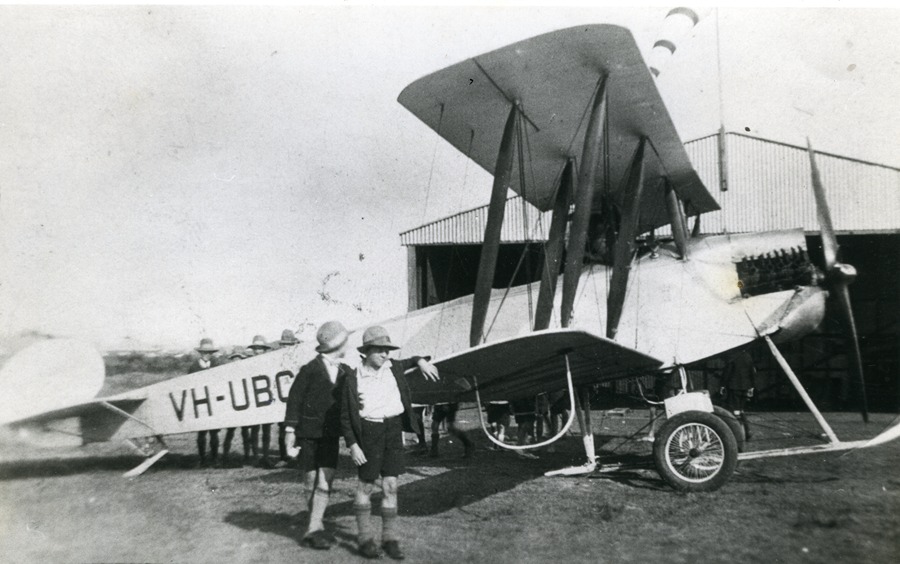
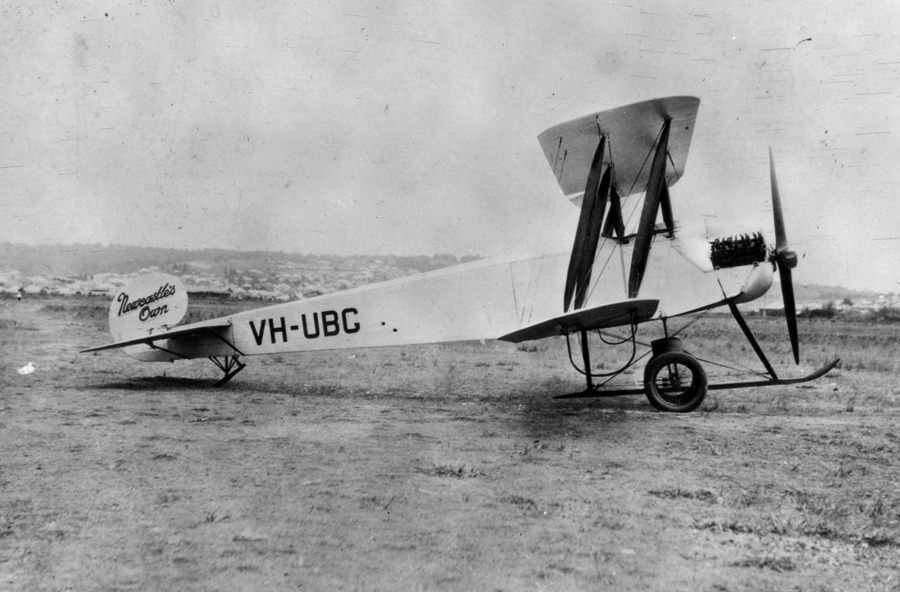
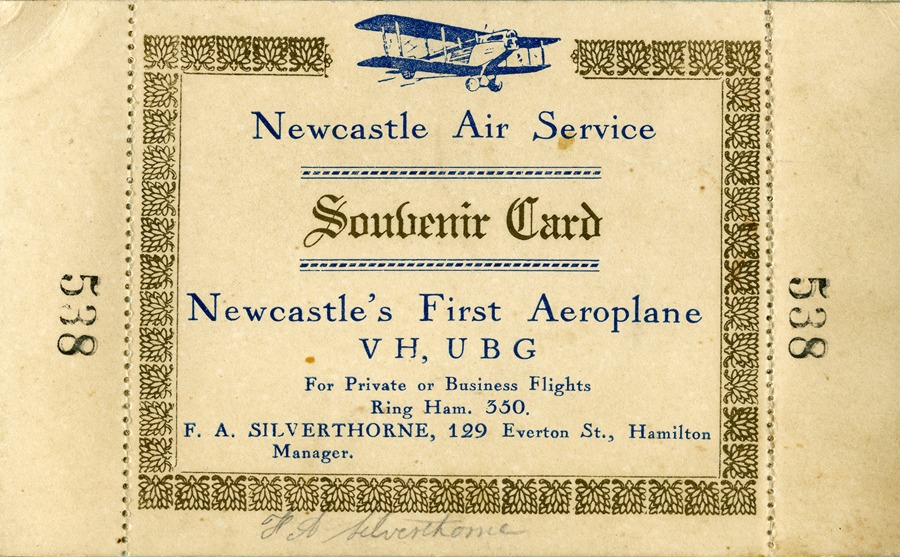
The syndicate operators were Frank Silverthorne, Herb O’Shannessy and the pilot – ex Royal Flying Corps flyer Stan Preston. The Newcastle Morning Herald reported the arrival of the plane in Newcastle in September 1929. The little two-seater had flown from Melbourne over a couple of days “in easy stages”, with Mr Silverthorne as a passenger. The syndicate had built a hangar at District Park and the plan was to use the plane to provide weekend passenger flights and to test demand for possible expanded business. The owners painted “Newcastle’s Own” on the tail. After a series of successful flights it was reported in the hefty Civic Week souvenir booklet published in Newcastle in 1929 that: “Businessmen with their hard-headed desire of keeping at least one foot on terra firma will no longer look askance at the aeroplane, but will take advantage of the service now being inaugurated and travel – for example to Sydney – by air in comfort in some forty minutes or so, enjoying en route scenery unsurpassed anywhere in the Commonwealth”. Some businesspeople certainly used the service, but presumably not enough to make the operation viable.
Originally powered by a Sunbeam Dyak motor, the aircraft was refitted in 1931 with a V8 replacement engine. Its registration was cancelled in 1932 and, according to information supplied to Newcastle pilot and aviation enthusiast Bill Hitchcock, Stan Preston eventually took it to Archerfield, Queensland. A replica of the aircraft is on display at Sydney’s Mascot airport.
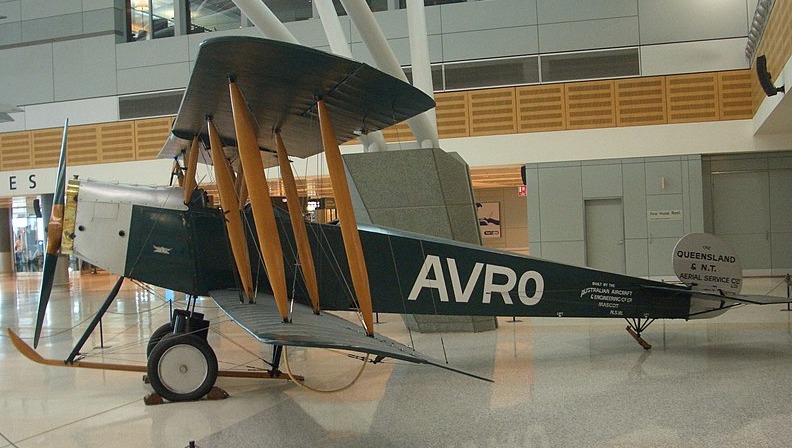
In 1933 an interesting aircraft was built at Sydney’s Cockatoo Dock. The twin-engined monoplane was designed by Wing Commander Lawrence Wackett to the specifications of Sir Charles Kingsford Smith, who was still trying to start a viable aviation business following the failure of his Australian National Airways venture. Kingsford Smith had hoped the new aircraft would make a trans-Tasman flight to New Zealand as a precursor to a regular mail service, but this did not eventuate. The plane, completed in 1934, was named Codock (after the place where it was built) and it was the only one of its type to be built. The design later evolved into the Gannet utility transport plane.
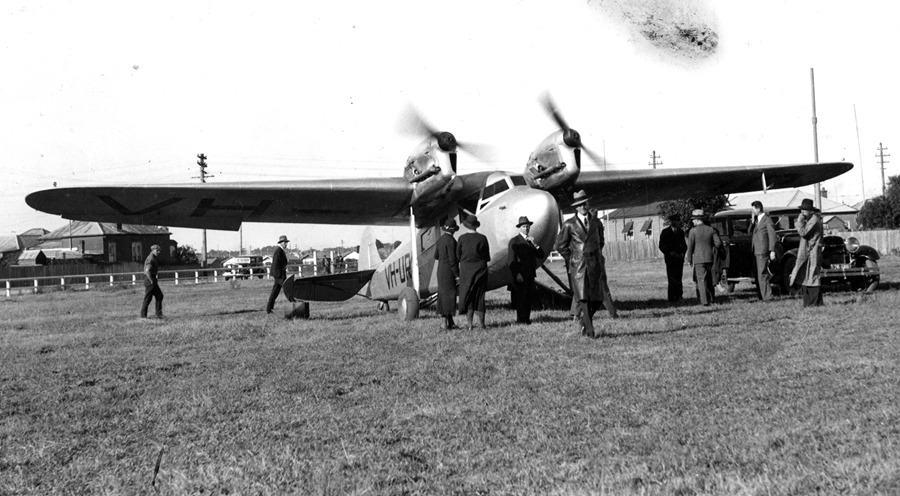
The Codock was bought from Kingsford Smith by a Newcastle-based company named Northern Airways Limited in 1934, with the proceeds of the sale apparently funding the renowned airman’s purchase of a new plane in which to contest the Centenary Air Race. Northern Airways failed to keep up its payments and was wound up at Kingsford Smith’s petition in April 1935. The Codock, in the meantime, had moved straight into the ownership of a new firm named Northern Airliners Limited, which was apparently at least partly bankrolled by prominent Hunter Valley identity George Edward Ryder – well-known for his extensive sporting and racing interests and his ownership of the successful Rover Motors bus company. The switch in company names may have been a piece of paper-shuffling, since the operation appears to have used both names – Northern Airways and Northern Airliners – more or less interchangeably. George Ryder was cited as manager of Northern Airways in this article in June 1934.
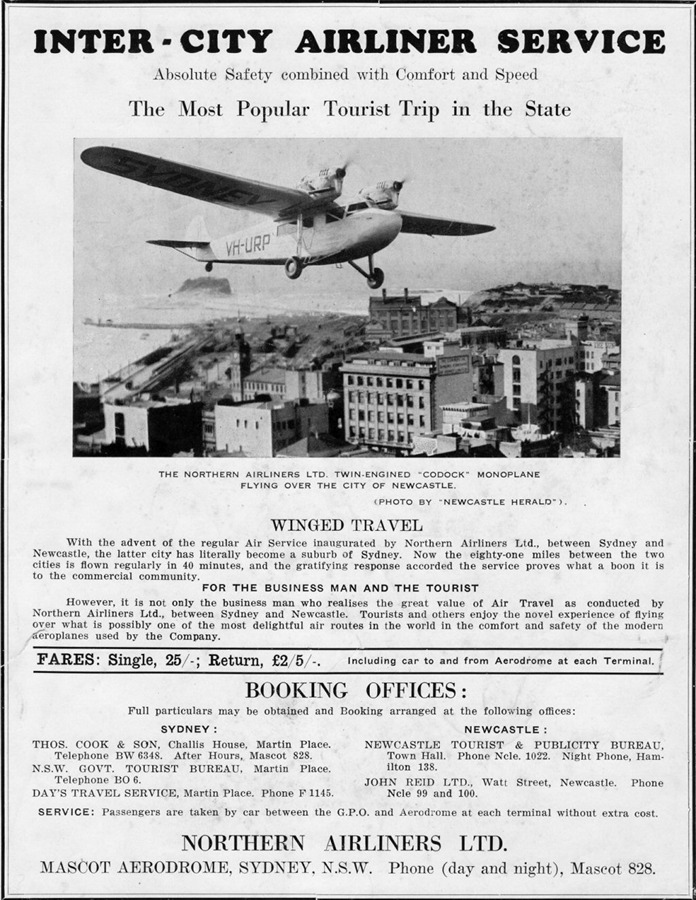
Northern Airliners Limited started flying the Codock between District Park and Sydney on June 11, 1934, offering up to 18 services a week in each direction. The company also flew a de Havilland DH.50 (named Codette) which made news in December 1934 when it made a forced landing at Manly Golf Course.
It seems that “Smithy” had some involvement in the Northern Airliners service, since he sometimes stood in for the New Zealander chief pilot, Squadron Leader “Tiny” White, who by August 1934 had reportedly flown the Codock 24,000 miles and carried almost 2000 passengers. White had been brought to Australia by Kingsford Smith to fly the proposed trial trans-Tasman mail service. Sometimes Smithy’s other planes – including the Southern Cross and his Percival Gull – were used as substitutes for the Codock if it was out of service for some reason.
For some reason the Codock was in Wollongong on May 6, 1935 where it was severely damaged in a landing accident and had its airworthiness certificate suspended. Northern Airliners ceased operation and was wound up, selling the Codock to new owners.
New England Airways took over the route after the demise of Northern Airliners but the service was discontinued when Airlines of Australia Limited bought New England out. Airlines of Australia soon announced, however, that it would operate two flights a day each way between Newcastle and Sydney from October 1936, flying new trimotor Stinson monoplanes.
In September 1938 a company known as Safety Airways (Newcastle) Limited was reported as being about to run five trips a day using two Dragon Rapides between Newcastle and Sydney’s Rose Bay. In Newcastle the planes were to have a landing base in the Basin and would embark and disembark passengers at the eastern end of Lee Wharf. It is unclear whether the service ever actually began.
